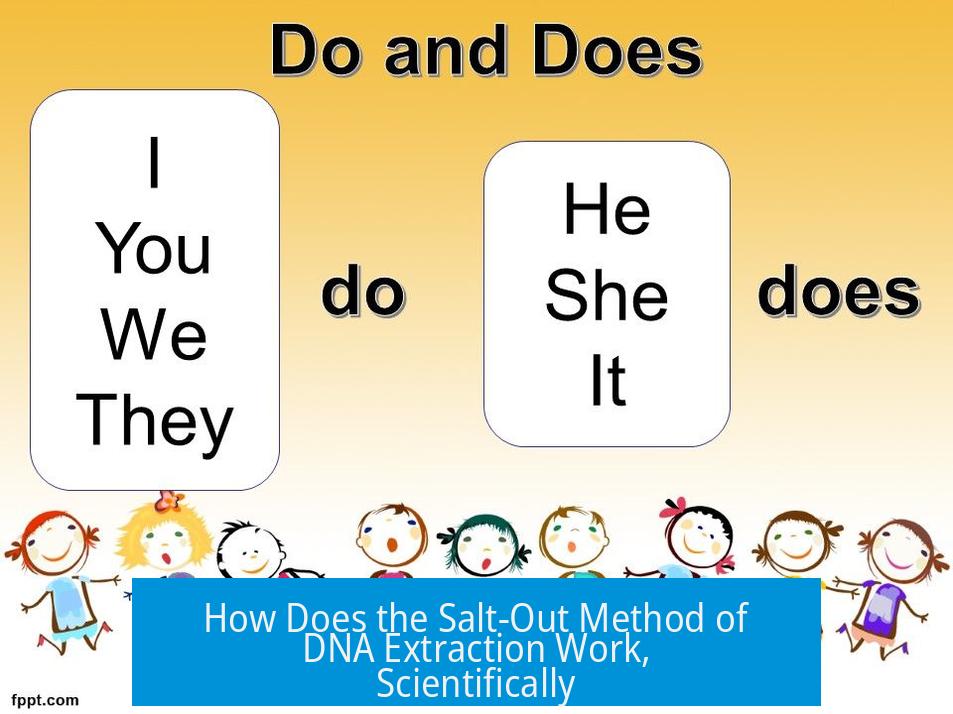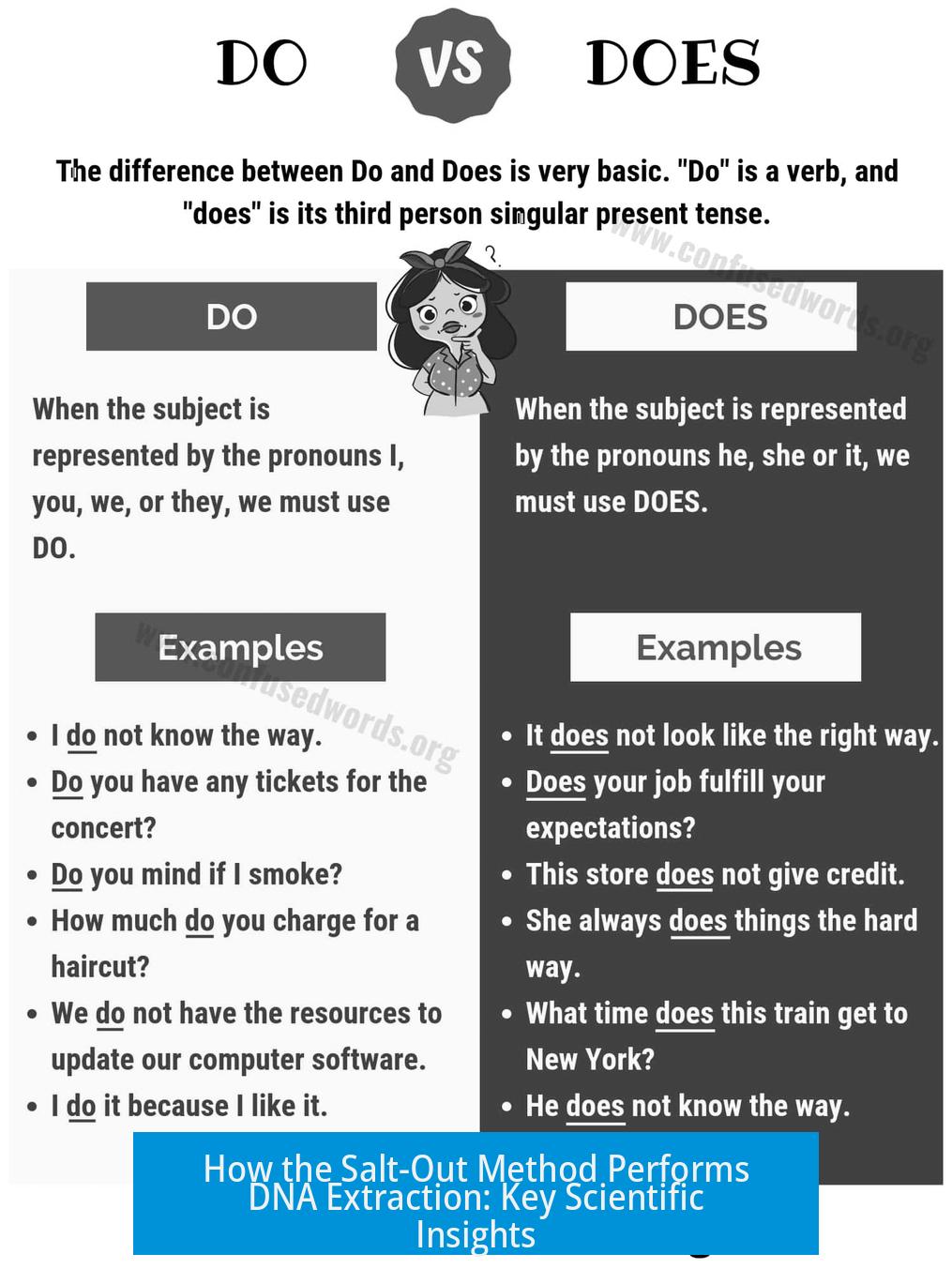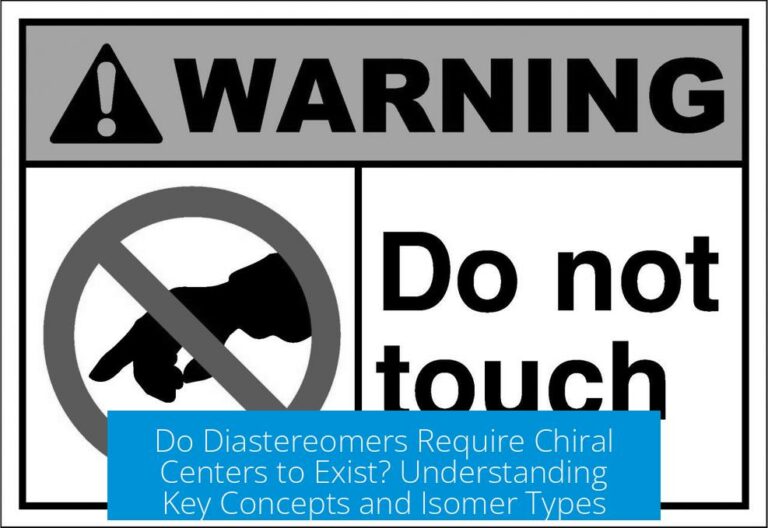How Does the Salt-Out Method of DNA Extraction Work, Scientifically?

The salt-out method of DNA extraction works by first neutralizing the DNA’s negatively charged phosphate backbone with high concentrations of salt, typically sodium acetate (NaAc), thereby reducing DNA’s solubility in water. Ethanol is then added to further prevent DNA solvation by water, encouraging DNA molecules to aggregate and precipitate out of the solution. This process separates DNA from cellular debris and proteins, although subsequent purification steps are often necessary to remove contaminating proteins.
The Role of Salt in DNA Precipitation
The DNA molecule contains a backbone with phosphate groups that carry negative charges. In aqueous solution, these phosphate groups interact strongly with water molecules, making DNA highly soluble. The salt-out method exploits the ionic nature of DNA by adding a high concentration of salt, commonly sodium acetate (NaAc).
- Salt cations (Na+) bind to the negative phosphate groups on DNA.
- This binding neutralizes charges along the DNA backbone.
- Neutralization decreases the electrostatic repulsion between DNA strands.
- The water molecules can no longer stabilize the DNA as efficiently due to ionic competition.
High concentrations of salt “saturate” the solution with ions, which limits the amount of water available to solvate DNA. This process creates an environment where DNA molecules lose their hydration shells and become less soluble. The reduction in solubility is crucial for DNA to precipitate during subsequent steps.
Ethanol’s Role in DNA Precipitation After Salt Binding
Following salt addition, ethanol is introduced into the solution. Ethanol is less polar than water and competes for hydration around molecules.
- Ethanol lowers the dielectric constant of the solution, weakening DNA-water interactions.
- It reduces water activity, increasing the effective concentration of DNA.
- DNA molecules thus cluster together due to fewer interactions with solvent molecules.
- This clustering results in the formation of visible DNA precipitates.
However, ethanol does not exclusively cause DNA precipitation. Proteins, especially denatured proteins, may also precipitate or coprecipitate. To purify DNA further, phenol:chloroform extraction frequently follows this step to separate proteins from nucleic acids due to their differential solubility in organic solvents.
Hydrophilicity Differences Between DNA and Protein Affecting Extraction
In the salt-out extraction, the differing chemical properties of DNA and proteins facilitate their separation. DNA is composed of nucleotides with polar groups, making it highly hydrophilic.
- Each nucleotide’s phosphate and sugar moieties attract water.
- DNA strands are large and negatively charged, enhancing solubility in aqueous solutions.
Conversely, proteins have complex three-dimensional structures incorporating hydrophobic cores. This hydrophobicity means:
- Proteins are less soluble in water than DNA under many conditions.
- They tend to aggregate and precipitate under alcohol precipitation conditions.
While proteins are less soluble, some protein contaminants often coprecipitate with DNA using salt and ethanol methods. This is partly why additional purification steps such as phenol:chloroform extraction or doped precipitation agents are required. Polyethylene glycol (PEG) precipitation is a more selective alternative for DNA because it preferentially induces DNA precipitation without pulling down as many proteins.
Limitations and Alternatives of Salt-Out Method
The salt-out DNA extraction method poses practical challenges when scaling.
- Phenol:chloroform extraction generates hazardous organic waste.
- This makes large-scale or automated workflows difficult.
- Phenol is toxic and requires careful disposal and handling.
Due to these limitations, modern molecular biology often prefers paramagnetic bead-based extraction techniques. Bead matrices can selectively bind DNA in a scalable and automatable manner without toxic solvents. However, salt-out methods remain relevant for small-scale, cost-sensitive, or specific applications. Commercial kits, such as the MasterPure DNA extraction kit, utilize salt-out principles combined with improved cleanup procedures.
Summary of the Scientific Principles Behind Salt-Out DNA Extraction
| Step | Scientific Basis | Outcome |
|---|---|---|
| Salt Addition (e.g., NaAc) | Neutralizes DNA phosphate charges, saturates ionic environment, reduces DNA solubility | DNA becomes less soluble, ready for precipitation |
| Ethanol Addition | Competes for hydration, lowers dielectric constant, drives DNA aggregation | DNA precipitates as a visible pellet |
| Protein Contamination | Proteins partially hydrophobic, may coprecipitate with DNA | Requires additional purification (e.g., phenol:chloroform extraction) |
| Extraction Cleanup | Phenol:chloroform separates proteins and nucleic acids | Purified DNA for downstream applications |
Key Takeaways
- Salt binds to DNA’s negative phosphate groups, reducing DNA’s solubility in water.
- Ethanol reduces water availability, causing DNA molecules to clump and precipitate.
- Differences in hydrophilicity between DNA and proteins allow partial separation, but protein contamination is common.
- Phenol:chloroform extraction often follows salt-out to remove proteins effectively.
- Salt-out methods generate chemical waste and are less suited to high-throughput workflows.
- Bead-based extraction methods offer safer, scalable alternatives.





Leave a Comment